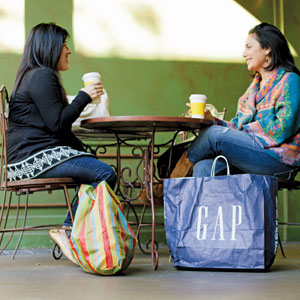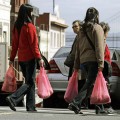San Jose’s plastic bag ordinance will save local creek bed ecosystems, bankrupt mom-and-pop shops, drastically alter consumer habits, spark grocery store riots on Thanksgiving, bring down the plastics industry and destabilize the global economy—all at the same time. Or it could just force shoppers to bring their own bags to avoid a 10-cent fee per paper sack.
The truth is, the complexity of the new law, which went into effect Jan. 1, has less to do with any potential fallout as where and how the ban is being implemented. The bag ban’s impact is best found in the invisible boundry line that intersects Valley Fair Mall on Stevens Creek Boulevard. The San Jose city limit cannot be seen or felt, but the divide between San Jose and Santa Clara is stark. The Santa Clara side starts near Gap and runs through the Macy’s men’s department, according to Laura Vestal, the mall’s marketing director.
Customers at Macy’s women’s department, which resides on the San Jose side of Valley Fair, were seen carrying out new clothes on hangers if they forget bags, while some stores on the Santa Clara side have no intention of changing their habits or may not understand the complexity of the law.
“The ban didn’t affect us at all, because we don’t have plastic bags,” says a woman behind the counter at Louis Vuitton. No one bothers to tell her that the expensive hand bags the store sells are covered in some type of polyurethane coating, which may or may not fall under the ordinance.
The reality is the bag ban was never designed to pit stores against one another; it was to nudge other cities into action. San Jose wants to set a local trend that already is spreading across the country.
“Palo Alto was a bit ahead of us, Sunnyvale is right on our heels, Milpitas is looking at [a bag ban], and other cities are looking at it but it’s hard to say if it’s going to move,” says Sam Liccardo, a San Jose city councilmember. “I think a lot of folks are sitting back to wait and see how it works out in San Jose. We recognize the leadership role that San Jose plays in the region, and it would be very difficult to persuade any small towns to dip their toe in the water first.”
Joining Councilmember Kansen Chu, who was the first person in San Jose to suggest a ban back in January 2008, Liccardo helped shepherd the city through a two-year struggle to craft an ordinance while coming into the crosshairs of paid lobbyists.
“They’re spending a lot of time in individual cities,” Liccardo says of plastics industry lobbyists. “They’re worried about the contagion effect. But the hope is that when several large cities have moved together on initiatives like this, Sacramento will not be far behind. Then this won’t be an issue on which side of the city limits you live on, but that this will be a statewide issue.”
The two biggest opponents of the plastic bag ban in San Jose from 2008 through 2010 were lobbyists Manny Diaz and Ed McGovern. According to the city’s website, which does not have all records available online, Diaz was paid a minimum of $80,000 by the American Chemistry Council for his lobbying of city officials during a two year period ending in October 2009. Online records show the same group paid McGovern at least $21,000 in 2010 to lobby city officials to reject enactment of a similar ban aimed at Expanded Polystyrene, otherwise known as single-use Styrofoam containers, for San Jose restaurants this summer.
“They definitely spent a lot of time and money,” Chu says. “I know they came and talked to me many times over the years, and I know they were also definitely influencing the state legislature.”
Merchants in San Jose had a full year to prepare for compliance with the ban, and the clamor over the change has been meek. But the debate on the harm plastic bags cause the environment has intensified as other areas consider implementation of similar bans.
Seattle recently approved a bag ban similar to San Jose—except the fee for paper bags is 5 cents each instead of 10—which now faces a referendum-like effort to repeal the law. The opponent in that effort is reportedly a private citizen, but plastics manufacturers have heavy pockets in a fight to save an industry that in 2007 employed a million people and created $374 billion in plastics.
Bags That Bad?
Stephen Joseph, the lead counsel for the website Save the Plastic Bag, says that arguments about plastic bags harming the environment are overblown and in many cases outright fabrications. Dismissing the Great Plastic Garbage Patch—a floating island of plastic trash said to be in the Atlantic Ocean—as a myth, the San Francisco—based attorney with an English accent says that baseless claims by politically motivated environmentalists threaten the public more than the products they target.
{pagebreak}
“We’re supposed to be the corporate bullies who lie and deny, and they’re whiter than snow and they would never tell a lie and never make up any statistics,” Joseph says. “That’s the problem—anything they say, the congregation has to say, ‘Amen!’ Anything we say, it mustn’t be true because we’re saying it. But that’s the way it is on the left. By the way, I’m a Democrat.”
Joseph’s arguments against plastic bag bans are passionate and thorough. He’s done this before, pushing back against a growing number of cities across the country considering bans. Santa Cruz County is considering scaling back its ban to allow restaurants to distribute single-use bags for take-out customers, which is how San Jose’s ban is structured. A threatened lawsuit from Joseph inspired the change of heart.
“The reason I’m doing this is because I consider myself the ultimate environmentalist,” he says. “You cannot make environmental policy based on lies. If we environmentalists are not true, we’re not honest, what good are we?”
But the logic of plastics industry advocates starts to wear thin when one wonders how to argue that reusable bags are worse for the environment than single-use plastic and paper bags.
“Reusable bags don’t come from Heaven,” Joseph says. “Nearly all the reusable bags that are replacing the plastic bags come from China. The plastic bags we use in America, 85 percent are made in America.”
And then: “The problem with people reusing reusable bags, they’re so large you can’t really carry them around everywhere.”
According to city officials in San Jose, not only are businesses overwhelmingly complying with the plastic bag ban, customer complaints have also been nearly non-existent.
Jennifer Garnett, a spokesperson for the city’s Environmental Services department, says more than 5,000 retailers were sent returnable certificates detailing the ordinance, which forbids handled plastic bags and forces stores to charge a 10 cent fee for paper bags. (The fee goes up to 25 cents in 2014.) About a third of those businesses responded by returning the certificates and self-registering, Garnett says, and since the ban went into effect, only eight citizen complaints have been voiced to the city about stores not abiding by the ban.
The domino effect continues to take shape. Sunnyvale is currently crafting its own ordinance, made easier by the Environmental Impact Report (EIR) that San Jose conducted. Melinda Hamilton, Sunnyvale’s former mayor, sent a letter thanking the city for its guidance. Milpitas took its own steps in October of last year, and Monterey is now on its way to banning single-use plastic bags as well. The hope at San Jose’s City Hall is that the rest of the county is on its way to joining the ban, if for no other reason than to avoid more Valley Fair Mall situations.
“We want to push it countywide,” Chu says, “so we don’t have people confused if they live in San Jose and they cross the street and there are different rules governing them.”

 Review: Main Street Burgers
Review: Main Street Burgers  Live Feed: Sachin Chopra
Live Feed: Sachin Chopra 

